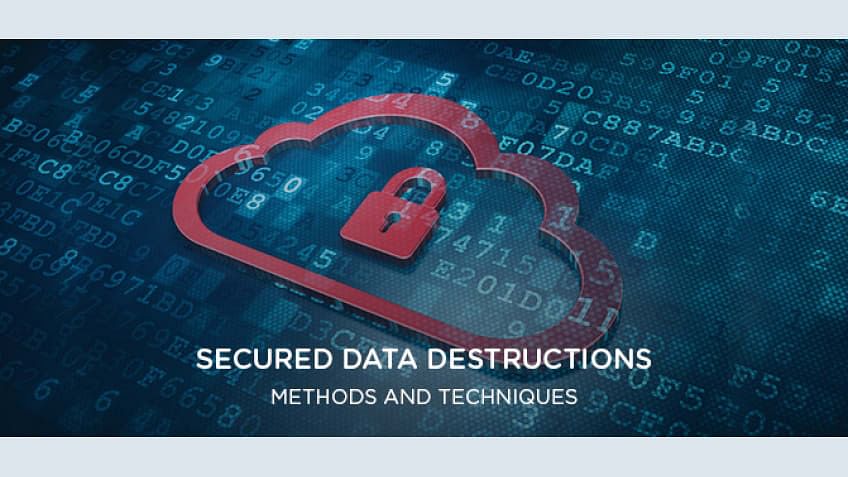Why Data Destruction is a Vital Part of Comprehensive Cyber Security
Why Data Destruction is a Vital Part of Comprehensive Cyber Security
Blog Article
Just How Correct Data Destruction Adds to Robust Computer Safety And Security Providers and Mitigates Dangers of Data Violations
In today's electronic landscape, the relevance of appropriate information damage can not be overstated, as it acts as a fundamental part of thorough computer system safety and security services. By implementing efficient information erasure techniques, companies not only protect delicate info from unauthorized accessibility but additionally strengthen their conformity with governing frameworks - data destruction. The ramifications of inadequate data devastation expand beyond simple compliance; they can profoundly influence an organization's cybersecurity posture and credibility. Understanding these measurements increases important concerns about the techniques in position and their performance in a period of escalating cyber dangers.
Relevance of Information Damage
In today's digital landscape, the significance of data damage can not be overstated. As companies increasingly rely upon digital assets, the prospective risks related to data violations and unauthorized access intensify. Reliable information devastation is a vital element of a thorough info protection approach, guarding delicate details from coming under the hands of destructive actors.
When data is no more required, merely deleting data or formatting hard disks is inadequate. Residual data can typically be recuperated utilizing readily available tools, presenting substantial risks to both people and organizations. This highlights the need for robust data destruction methods that guarantee all data is irretrievably removed.
Furthermore, regulative compliance requireds, such as GDPR and HIPAA, highlight the responsibility to shield sensitive data, including its proper disposal. Non-compliance can cause serious legal repercussions and financial penalties. data destruction. Therefore, incorporating efficient data devastation procedures not only enhances safety and security but additionally strengthens an organization's reputation and dependability

Techniques of Secure Data Erasure
Numerous efficient approaches of secure information erasure can be employed to guarantee that sensitive info is permanently gotten rid of from storage tools. One widely recognized method is data overwriting, which includes changing existing information with arbitrary patterns numerous times. This technique significantly reduces the opportunities of data healing, although it may not be efficient versus sophisticated forensic methods.

Physical damage is also a trusted technique, where storage space devices are made pointless via shredding, crushing, or incineration. This technique makes sure that information can not be recuperated whatsoever but calls for mindful handling of dangerous materials.
Lastly, specialized software tools designed for safe and secure information erasure give capabilities that adhere to numerous erasure criteria. These tools typically include functions like verification processes to validate effective information destruction.
Employing these methods in combination can boost information protection and alleviate the risks associated with information breaches, guaranteeing that sensitive details is not accidentally revealed.
Legal and Compliance Factors To Consider
The approaches utilized for safe information erasure not just offer to secure sensitive info but likewise must line up with legal and compliance structures regulating data defense. Organizations are needed to adhere to different guidelines, such as the General Data Security Guideline (GDPR), the Medical Insurance Portability and Liability Act (HIPAA), and the Settlement Card Market Data Security Requirement (PCI DSS) These policies mandate particular procedures for data managing and devastation, guaranteeing that individual and delicate information is irretrievably erased when no more required.
Failing to conform with these lawful needs can cause significant fines, including penalties and reputational damages. Additionally, companies should keep documents of data devastation processes, demonstrating conformity during audits or examinations. This paperwork not only protects versus legal repercussions however also enhances trust with stakeholders and consumers, showcasing a commitment to information safety.
Incorporating legal and conformity factors to consider right into information damage methods is necessary for any company. It lessens the danger of information violations and shows a proactive approach to safeguarding delicate information, inevitably promoting a culture of security and responsibility across the organization.
Impact on Cybersecurity Stance
Reliable information damage considerably boosts a company's cybersecurity posture by lowering the prospective strike surface for cyber dangers. When sensitive data is not properly destroyed, it remains easily accessible to destructive actors that can exploit this details for unapproved accessibility, identification theft, or business espionage. By carrying out robust information devastation procedures, companies can successfully decrease the risk of information breaches and improve their overall security structure.
In addition, the secure disposal of unnecessary or out-of-date data not only secures delicate info yet additionally helps companies adhere to sector regulations and requirements. Failing to appropriately damage information can bring about extreme legal effects and reputational damages, further compromising an organization's cybersecurity position.

Eventually, prioritizing effective data damage is essential for promoting a durable cybersecurity stance, guaranteeing that companies continue to be cautious against developing cyber risks while protecting their essential properties and stakeholders.
Best Practices for Organizations
Applying ideal practices for data devastation is crucial for organizations intending to guard delicate information and mitigate cybersecurity threats. Organizations ought to establish a detailed information damage policy that describes procedures and responsibilities. This policy needs to adhere to pertinent laws, such as GDPR or HIPAA, ensuring legal conformity.
Second of all, it is vital to make use of you can find out more authorized data sanitization approaches, including information wiping, degaussing, and physical damage, customized to the kind of information and storage space medium. Utilizing licensed experts for information damage solutions boosts the reliability of these techniques.
Moreover, organizations should maintain a thorough stock of all information storage tools, ensuring that these details all obsolete or changed devices undertakes destruction. Normal audits of data damage practices can aid improve and recognize weak points conformity.
Staff member training is an additional important facet, as personnel has to understand the relevance of information destruction and follow developed protocols. Organizations should record all information damage tasks to give liability and traceability, which can be invaluable during audits or in the event of a violation.
Verdict

One commonly recognized strategy is data overwriting, which involves replacing existing data with random patterns several times.The methods utilized for protected data erasure not just serve to shield sensitive information yet additionally must straighten with lawful and compliance structures governing data security. These regulations mandate certain methods for data taking care of and destruction, making sure that individual and sensitive information is irretrievably removed when no longer required.
By executing robust data damage procedures, companies can properly minimize the risk of data breaches and improve their general protection framework.
In final thought, appropriate information devastation is essential for enhancing read computer safety solutions and minimizing the risks associated with data breaches. - data destruction
Report this page